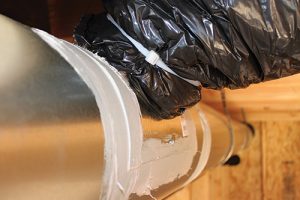 It’s amazing how much energy a home can waste when the ductwork isn’t properly sealed. Leaky ducts can result in heat loss of up to 20 percent, raising monthly utility bills.
It’s amazing how much energy a home can waste when the ductwork isn’t properly sealed. Leaky ducts can result in heat loss of up to 20 percent, raising monthly utility bills.
A thorough and complete duct sealing will increase the heating and cooling efficiency of a new home, help lower energy costs and improve comfort and indoor air quality. It can also help you earn an EPSTM to promote the high quality and efficient performance of your newly built homes.
While it’s important to pay careful attention to all ductwork, unconditioned areas, such as attics and crawl spaces, suffer the greatest losses when it comes to heating and cooling system performance. To prevent duct leakage, apply mastic paste of at least a nickel thick when the duct system is installed. Testing has shown that even expensive UL-listed mastic tapes don’t hold up over time as well as mastic paste.
Seal all connections, seams and joints with mastic paste, including the air handler, which can be a main source of leakage if seams aren’t properly sealed around the sheet metal housing. Because mastic can be messy, many HVAC contractors find it’s easiest to put it on the inside of fittings before they’re assembled. This is often done ahead of time under controlled conditions. Apply mastic with a disposable brush, a putty knife or by hand while wearing gloves.
Thorough duct sealing produces benefits beyond improving efficiency and lowering energy costs. It can solve common comfort problems, such as rooms that are too hot in the summer or too cold in the winter, it improves indoor air quality by reducing the risk of fumes and pollutants entering the duct system, and it can also help with proper air balancing.
For more information on duct sealing, including an online training video, visit Energy Trust’s Residential Training page or call 1.877.283.0698.

